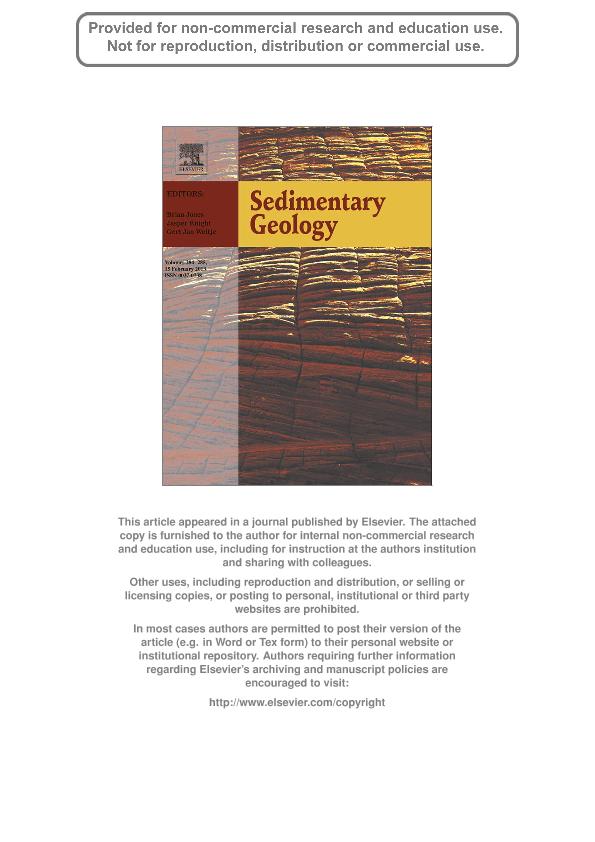Mostrar el registro sencillo del ítem
dc.contributor.author
Cabaleri, Nora Graciela

dc.contributor.author
Benavente, Cecilia Andrea

dc.date.available
2022-12-27T11:44:35Z
dc.date.issued
2013-12
dc.identifier.citation
Cabaleri, Nora Graciela; Benavente, Cecilia Andrea; Sedimentology and paleoenvironments of the Las Chacritas carbonate paleolake, Cañadón Asfalto Formation (Jurassic), Patagonia, Argentina; Elsevier Science; Sedimentary Geology; 284-285; 12-2013; 91-105
dc.identifier.issn
0037-0738
dc.identifier.uri
http://hdl.handle.net/11336/182449
dc.description.abstract
The Las Chacritas Member is the lower part of the Cañadón Asfalto Formation (Jurassic). The unit is a completely continental limestone succession with volcanic contributions that were deposited during the development of the Cañadón Asfalto Rift Basin (Chubut province, Patagonia, Argentina). A detailed sedimentological analysis was performed in the Fossati depocenter to determine the paleoenvironments that developed in the context of this rift. The Las Chacritas Member represents a carbonate paleolake system with ramp-shaped margins associated with wetlands that were eventually affected by subaerial exposure and pedogenesis. This process is represented by three main subenvironments: a) a lacustrine setting sensu stricto (lacustrine limestone facies association), represented by Mudstones/. Wackestones containing porifera spicules (F1), Intraclastic packstones (F6) and Tabular stromatolites (F10) in which deposition and diagenesis were entirely subaqueous; b) a palustrine setting (palustrine limestone facies association) containing Microbial Mudstones (F2), Intraclastic sandy packstone with ostracode remains (F3), Oncolitic packstone (F5), Brecciated limestone (F7) and Nodular- Mottled limestone (F8) representing shallow marginal areas affected by groundwater fluctuations and minor subaerial exposure; and c) a pedogenic paleoenvironment (pedogenic limestone facies association) including Intraclastic limestone (F4) and Packstones containing Microcodium (F9) facies displaying the major features of subaerial exposure, pedogenic diagenesis and the development of paleosols. The fluvial-palustrine-lacustrine succession shows a general shallow upward trend in which contraction-expansion cycles are represented (delimited by exposure and surface erosion). The variations in the successive formations reflect the responses to fluctuations in a combination of two major controls, the tectonic and local climatic variables. The predominance of the palustrine facies associations was determined by its accommodation space as well as the local climate conditions. The variations in the lacustrine limestone facies associations reflect differential patterns of subsidence within the sub-basin. The diagnostic features of the palustrine limestone facies associations (organic matter (OM) content, microinvertebrate fauna, abundant mud cracks, brecciation, presence of evaporitic minerals) frame the sub-basin in a climatic context intermediate between arid and subhumid conditions.
dc.format
application/pdf
dc.language.iso
eng
dc.publisher
Elsevier Science

dc.rights
info:eu-repo/semantics/openAccess
dc.rights.uri
https://creativecommons.org/licenses/by-nc-sa/2.5/ar/
dc.subject
CARBONATE
dc.subject
LACUSTRINE
dc.subject
PALEOENVIRONMENTS
dc.subject
PALUSTRINE
dc.subject.classification
Geociencias multidisciplinaria

dc.subject.classification
Ciencias de la Tierra y relacionadas con el Medio Ambiente

dc.subject.classification
CIENCIAS NATURALES Y EXACTAS

dc.title
Sedimentology and paleoenvironments of the Las Chacritas carbonate paleolake, Cañadón Asfalto Formation (Jurassic), Patagonia, Argentina
dc.type
info:eu-repo/semantics/article
dc.type
info:ar-repo/semantics/artículo
dc.type
info:eu-repo/semantics/publishedVersion
dc.date.updated
2022-12-22T16:04:10Z
dc.journal.volume
284-285
dc.journal.pagination
91-105
dc.journal.pais
Países Bajos

dc.journal.ciudad
Amsterdam
dc.description.fil
Fil: Cabaleri, Nora Graciela. Consejo Nacional de Investigaciones Científicas y Técnicas. Oficina de Coordinación Administrativa Ciudad Universitaria. Instituto de Geocronología y Geología Isotópica. Universidad de Buenos Aires. Facultad de Ciencias Exactas y Naturales. Instituto de Geocronología y Geología Isotópica; Argentina
dc.description.fil
Fil: Benavente, Cecilia Andrea. Consejo Nacional de Investigaciones Científicas y Técnicas. Centro Científico Tecnológico Conicet - Mendoza. Instituto Argentino de Nivología, Glaciología y Ciencias Ambientales. Provincia de Mendoza. Instituto Argentino de Nivología, Glaciología y Ciencias Ambientales. Universidad Nacional de Cuyo. Instituto Argentino de Nivología, Glaciología y Ciencias Ambientales; Argentina
dc.journal.title
Sedimentary Geology

dc.relation.alternativeid
info:eu-repo/semantics/altIdentifier/url/https://www.sciencedirect.com/science/article/pii/S0037073812003247
dc.relation.alternativeid
info:eu-repo/semantics/altIdentifier/doi/http://dx.doi.org/10.1016/j.sedgeo.2012.11.008
Archivos asociados
